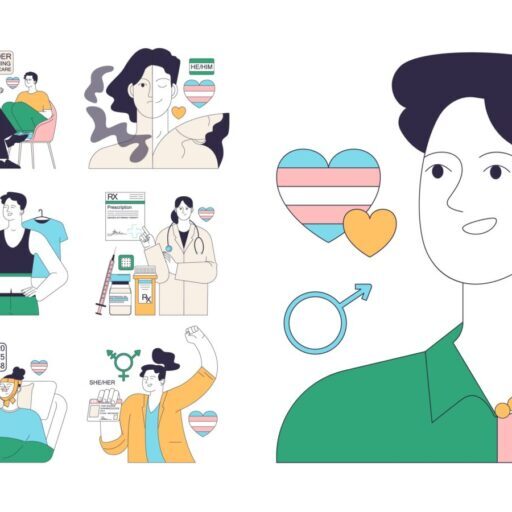Toolkit for Managing Panic Attacks

Panic attacks can be incredibly overwhelming and frightening experiences that, without coping skills for anxiety, can leave you feeling helpless and out of control. Unfortunately, they are also relatively common, affecting millions of people each year.
As a therapist for anxiety in Chicago, I see most of my clients have experienced at least one (if not a lifetime) of panic attacks.
What is a panic attack?
The DSM-5 (Diagnostic and Statistical Manual of Mental Disorders, 5th edition) defines a panic attack as a sudden onset of intense fear or discomfort that reaches its peak within minutes. Common experiences include:
- Palpitations
- Sweating
- Trembling or shaking
- Sensations of shortness of breath or smothering
- Feelings of choking
- Chest pain or discomfort
- Nausea or abdominal distress
- Feeling dizzy, unsteady, lightheaded, or faint,
- Feelings of unreality
- Being detached from oneself
- Fear of losing control or going crazy
- Fear of dying
- Numbness or tingling sensations
- Chills or hot flushes
Panic attacks can happen unexpectedly or be provoked by a specific situation or object of fear. People who have experienced panic attacks may develop apprehension about future attacks, which can exacerbate their anxiety and lead them to avoid the settings or circumstances where they previously had an attack.
What causes panic attacks?
The human brain activates a fight-or-flight response when it perceives danger, whether real or imagined, and triggers the release of hormones like adrenaline and cortisol. These hormones prepare our bodies to deal with threat, even if the threat isn’t real. They also lead to physical reactions such as rapid heartbeat and heavy breathing.
Panic attacks arise when the body experiences this hormonal response of fight or flight, but there is no actual danger. Various factors are believed to contribute to the development of panic attacks, including:
- Genetics – having a family history of panic attacks or anxiety disorders
- Chronic and ongoing stress
- Experiencing a sudden traumatic event or significant life changes
- A history of physical or sexual abuse
- Substance abuse or withdrawal from drugs or alcohol
- Medical conditions such as heart disease, thyroid problems, or chronic pain
- Panic disorder, phobias, or other anxiety disorders
- Certain medications or supplements, such as those containing caffeine or stimulants
- Breathing difficulties or respiratory problems
- Sleep deprivation or irregular sleep patterns
- Nutritional imbalances or deficiencies
- Negative thinking patterns or distorted perceptions
- Environmental triggers, such as crowded places or enclosed spaces
- Intense physical activity or overexertion
- Hormonal changes, such as those experienced during menstruation or menopause.
Panic attacks can be scary and really uncomfortable. Consider these strategies to manage panic attacks effectively:
- Learn about panic and anxiety to understand the false alarm that unexplained panic can cause, triggered by the fight-or-flight response. Ask your doctor to explain the physiology of panic attacks, read Panic Attacks: What they are, why they happen, and what you can do about them, or engage with a therapist for anxiety that can help you learn more.
- Notice and label the sensations you experience during a panic attack without judging them, and avoid jumping to conclusions. The physical sensations won’t hurt you (although it feels like they will). Learn to recognize them as “just sensations.”
- Remind yourself that panic attacks are temporary and will pass to avoid fear of a worsening situation.
- Practice deep breathing, in through your nose for 4 seconds, hold for 1-2 seconds, and out for 5 seconds, to help slow your breathing and turn off the fight-or-flight response.
- Try Progressive Muscle Relaxation by tensing and releasing muscle groups throughout your body to relax your muscles. Start with your toes. Clench them as tightly as possible and hold for 3 seconds, then release. Work your way up your body, clenching and releasing each muscle group. Repeat as needed.
- Use mindfulness techniques to ground yourself in the present moment, and focus on your senses by experiencing 5 things you can see, 4 things you can touch, 3 things you can hear, 2 things you can smell, and 1 thing you can taste.
- Close your eyes to reduce sensory input and make it easier to focus on relaxation strategies.
- Repeat a calming phrase or mantra to remind yourself that you are thinking clearly and that everything will be okay.
- Visualize a safe, comfortable, or calm place in your mind to find a happy place, and use all five senses to explore and experience it.
- Hold an ice cube in your hand and focus on the coolness or pain that might arise in your hand.
- Recite the lyrics to your favorite song.
- Distract with media. Read an article or watch your favorite YouTube channel.
Of course, not all strategies will work for all people. The key is identifying strategies that are effective in managing your anxiety and panic.
Individual therapy can be an effective way to manage anxiety and reduce the frequency and severity of panic attacks. With the help of an anxiety therapist, you can learn to manage panic attacks and work through underlying issues that contribute to their existence. Schedule an appointment with one of our therapists today!
This blog is made for informational and educational purposes only. It is not medical advice.
The information in this blog is not intended to (1) replace a one-on-one relationship with a qualified licensed health care provider, (2) create or establish a provider-patient relationship, or (3) create a duty for us to follow up with you.



